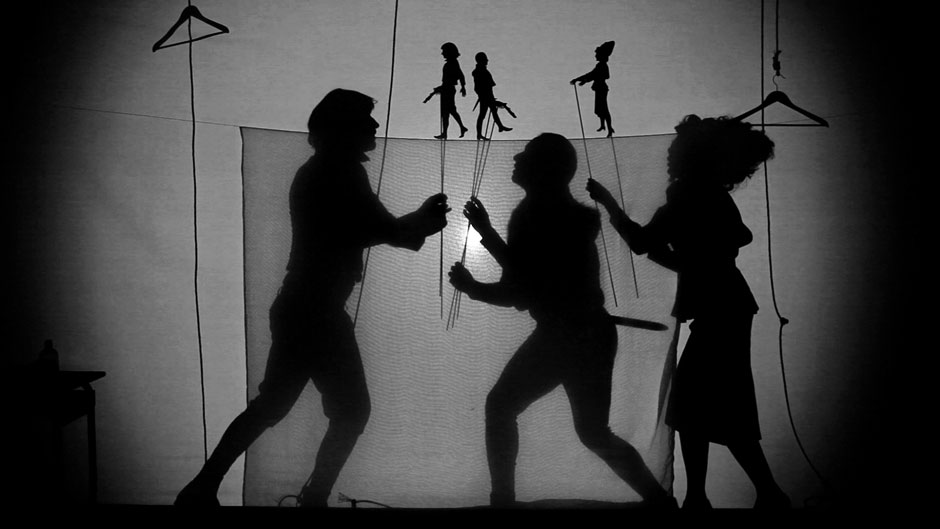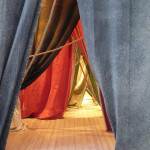Exhibition
in Zürich / Switzerland
- Ulla von Brandenburg: Shadowplay, 2012, Film still, Courtesy the artist and Art:Concept, Paris; Pilar Corrias, London; Produzentengalerie Hamburg, Photo: Laurent Montaron
- Ulla von Brandenburg: Shadowplay, 2012, Exhibition view Kunstverein Hannover 2014, Courtesy the artist and Art:Concept, Paris; Pilar Corrias, London; Produzentengalerie Hamburg, Photo: Raimund Zakowski
- Ulla von Brandenburg: Kulisy 2010, Exhibition view Kunstverein Hannover 2012, Courtesy the artist and Art:Concept, Pilar Corrias, Produzentengalerie Hamburg, Photo: Raimund Zakowski
- Ulla von Brandenburg: Portrait Ulla von Brandenburg, Photo: Jan Noordhoff, Courtesy the artist and Art:Concept, Paris; Pilar Corrias, London; Produzentengalerie Hamburg
Museum Haus Konstruktiv is the first Swiss institution to present a solo exhibition on the artist Ulla von Brandenburg, who was born in Karlsruhe in 1974 and lives in Paris. Her complex and luscious oeuvre includes specifically selected references to cultural history in a broad range of media. In her black-and-white films, installations, performances, murals, and drawings, she uses a vocabulary borrowed from theater. Her works interweave reality and fiction, the audience space and the stage space. Her works’ characteristic features include the use of shadows and mirrors (symbols of perception) and association-based, seemingly surreal texts, which are paired with paintings that are produced without any dependency on these texts, thus creating new contexts of meaning.
With the title ‘Manchmal Ja, manchmal Nein’ (Sometimes Yes, Sometimes No), Ulla von Brandenburg refers to Anton Chekhov’s comedy ‘Platonov’ (1880), in which the title character, a teacher, articulates the lack of principle in the society in which he himself feels trapped. Social criticism and the desire to alter life also provide the motive for many modern art movements. Ulla von Brandenburg establishes a link with Chekhov’s reduction of world affairs to the principles of rejection and acceptance – hence: ‘Sometimes Yes, Sometimes No’.
The exhibition begins with an installation created for Museum Haus Konstruktiv from differently colored curtains. Like in theater, curtains over a wooden floor mark a transition between the real world and the stage, where play and fiction prevail and people become actors. Individual objects in the space can be read as props, and also as design elements in a space-filling painting, the shadows of which make it difficult to reliably differentiate between reality and pretense.
This artist’s films are also presented in a site-specific manner, making reference to the givens of the architecture, as a space installation. They often address socio-cultural topics from various epochs, and fragmentarily show rituals and symbols that have been passed down to the present day. Ulla von Brandenburg’s films are shot entirely in black and white, and deliberately avoid being directly associated with any particular temporal context. For the films’ texts, which are mostly sung, the artist uses the ‘automatic writing’ method, which was applied by the surrealists and described by André Breton as ‘dictation of thought, in the absence of any control exercised by reason’. In ‘Shadowplay’ (2012), a life-size shadow theater is seen, with actors putting on their costumes and wigs before a performance, like in real life. They hang their clothes on coat hangers that are pulled upward on cords, and perform with silhouette figures that represent their selves. They complain about their lives as actors, with phrases like ‘Verbeugen bis zum Knie. Ich mocht’ es nie’ (‘Bowing down to one’s knees. I never liked it.’) or ‘Diese Rolle bis zum Ende’ (‘This role until the end’). In their allusions, the divide between the role and the real person is blurred, whereupon the illusion reveals itself: as a simultaneous yes and no from a real/fictional existence.
In her latest works, Ulla von Brandenburg arranges objects such as dream-catchers, ribbons, rods, and ropes – along with canvases. The fabrics, previously folded and treated with light-sensitive substances, show only the shadows of inscribed folds and resemble illusionistic drapery. They appear to cover openings – concealed portals, with which the artist entices us into a surreal world.
René Zechlin describes Ulla von Brandenburg’s installations as ‘allegories for the theater as a symbol of life and for the complex link between theater and reality, illusion and reflection. She gives us a glimpse behind the scenes of life, without ruining the allure of her own game. With every image exposed by von Brandenburg as illusion, shadow or reflection, a new, equally complex image emerges’.
This artist’s solo show, which coincides with the Sadie Murdoch exhibition and the historically oriented ‘DADA Differently’, spans two floors and includes works from recent years, along with presentations specially realized for this exhibition.
In the context of the exhibition, a publication is being released in cooperation with the ACCA in Melbourne, the Darling Foundry in Montreal, and The Power Plant in Toronto. In 2016, the artist shall present a solo exhibition with different works at each of these venues.
Ulla von Brandenburg has had numerous solo exhibitions, e.g.: ‘Sink Down Mountain, Rise Up Valley’, The Common Guild, Glasgow (2016); ‘Wagon Wheel’, Contemporary Art Museum St. Louis (2015); ‘Inside is not Outside’, Kunstverein Hannover (2014) and the Secession, Vienna (2013); ‘Das Versteck des W.L. ‘ (The Hiding Place of W.L.), Hamburger Kunsthalle (2013); Chisenhale Gallery, London (2009); the Irish Museum of Modern Art, Dublin (2008); and the CCA Wattis Institute for Contemporary Art, San Francisco (2008). She has also taken part in other major exhibitions, e.g. at the following institutions: Fondation Louis Vuitton, Paris (2015); MAMCO, Geneva (2015); Centre Pompidou, Paris (2015); CAC, Vilnius (2014); the 19th Biennale of Sydney (2014); the WIELS Contemporary Art Centre, Brussels (2013); the 11th Biennale de Lyon (2011); Schirn Kunsthalle, Frankfurt (2011); the 53rd Venice Biennale (2009); the Yokohama Triennale (2008); and Tate Modern (2007).
Curated by Sabine Schaschl.
Opening hours Tues 11 am – 5 pm, Wed 11 am – 8 pm, Thur-Sun 11 am – 5 pm
Als erste Schweizer Institution präsentiert das Museum Haus Konstruktiv eine Einzelausstellung der 1974 in Karlsruhe geborenen und in Paris lebenden Künstlerin Ulla von Brandenburg. Ihr komplexes und sinnliches Œuvre weist spezifisch ausgewählte kulturhistorische Referenzen in grosser medialer Bandbreite auf. In ihren Schwarz-Weiss-Filmen, Installationen, Performances, Wandmalereien und Zeichnungen nutzt sie ein Vokabular, das dem Theater entlehnt ist. Ihre Werke verzahnen Realität und Fiktion, Zuschauer- und Bühnenraum miteinander. Charakteristisch sind der Einsatz von Schatten und Spiegeln – Sinnbildern der Erkenntnis – sowie assoziativ entstandene, surreal anmutende Texte, die, gepaart mit den von ihnen unabhängig entstandenen Bildern, neue Sinnzusammenhänge schaffen.
Mit dem Titel “Manchmal Ja, manchmal Nein” bezieht sich Ulla von Brandenburg auf Anton Tschechows Komödie “Platonow” (1880), deren Titelfigur, ein Lehrer, die Ideen- und Prinzipienlosigkeit der Gesellschaft, in der er sich selbst gefangen fühlt, zur Sprache bringt. Gesellschaftskritik und der Wunsch, das Leben zu verändern, bilden auch das Movens vieler Kunstbewegungen der Moderne. Ulla von Brandenburg schlägt eine Brücke zu Tschechows Rückführung des Weltgeschehens auf die Prinzipien Ablehnung und Akzeptanz – also “manchmal Ja, manchmal Nein”.
Eine für das Museum Haus Konstruktiv geschaffene Installation aus verschiedenfarbigen Vorhängen bildet den Auftakt zur Ausstellung. Wie im Theater markieren Vorhänge über einem Bretterboden einen Übergang zwischen realer Welt und Bühne, wo Spiel und Fiktion vorherrschen und Menschen zu Akteuren werden. Einzelne Objekte im Raum können sowohl als Requisiten, wie auch als Gestaltungselemente einer den Raum füllenden Malerei gelesen werden, deren Schattenwürfe eine verlässliche Differenzierung von Wirklichkeit und Schein erschweren.
Auch die Filme der Künstlerin werden ortsspezifisch, das heisst auf die Gegebenheiten der Architektur bezugnehmend, als Rauminstallation präsentiert. Sie greifen vielfach soziokulturelle Themen aus unterschiedlichen Epochen auf und zeigen fragmentarisch Rituale und Symbole, die in die Gegenwart überliefert wurden. Ulla von Brandenburgs Filme sind ausschliesslich in Schwarz-Weiss gedreht und entziehen sich bewusst einer unmittelbaren zeitlichen Zuordnung. Für die meist gesungenen Filmtexte verwendet die Künstlerin die von den Surrealisten angewandte Methode der “écriture automatique”, die André Breton als “Denk-Diktat ohne jede Kontrolle der Vernunft” beschrieben hat. In “Shadowplay” (2012) ist ein Schattenspiel in Lebensgrösse zu sehen, mit Schauspielern, die – wie im realen Leben – vor der Aufführung ihre Kostüme anlegen und Perücken aufsetzen. Sie hängen ihre Kleider auf Bügel, die an Schnüren nach oben gezogen werden, und spielen mit Scherenschnitt-Figuren ihrer selbst. Sie beklagen sich über ihr Leben als Schauspieler – mit Sätzen wie “Verbeugen bis zum Knie. Ich mocht’ es nie” oder “Diese Rolle bis zum Ende”. In ihren Anspielungen verschwimmen Rolle und reale Person, womit sich die Illusion selbst entlarvt – als gleichzeitiges Ja und Nein einer real-fiktiven Existenz.
In den jüngsten Werken arrangiert Ulla von Brandenburg Gegenstände wie Traumfänger, Bänder, Ruten und Seile mit Leinwandbildern. Die zuvor gefalteten und mit lichtempfindlichen Substanzen behandelten Stoffe bilden nur mehr die Schatten eingeschriebener Faltenwürfe ab und wirken wie illusionistische Draperien. Sie scheinen Öffnungen zu bedecken – verborgene Portale, mit denen uns die Künstlerin in eine surreale Welt lockt.
René Zechlin beschreibt Ulla von Brandenburgs Installationen als “Allegorien über das Theater als Sinnbild des Lebens und über den vielschichtigen Zusammenhang von Theater und Realität, Illusion und Reflexion. Sie lässt uns hinter die Bühne des Lebens blicken, ohne die Faszination des eigenen Spiels zu zerstören. Mit jedem Bild, das von Brandenburg als Illusion, als Schatten oder Spiegelbild entlarvt, entsteht ein ebenso vielschichtiges Neues”.
Die Einzelschau der Künstlerin, die parallel zur Ausstellung von Sadie Murdoch und zur historisch angelegten Präsentation “DADA anders” stattfindet, erstreckt sich über zwei Stockwerke und zeigt neben Arbeiten der letzten Jahre auch speziell für die Ausstellung realisierte Inszenierungen.
Im Rahmen der Ausstellung erscheint eine Publikation in Kooperation mit dem ACCA, Melbourne, La Fonderie Darling, Montréal, und The Power Plant in Toronto, wo die Künstlerin 2016 jeweils eine Einzelausstellung mit unterschiedlichen Werken präsentiert.
Ulla von Brandenburg kann auf zahlreiche Einzelausstellungen verweisen, u.a.: “Sink Down Mountain, Rise Up Valley”, The Common Guild, Glasgow (2016); “Wagon Wheel”, Contemporary Art Museum St. Louis (2015); “Inside is not Outside”, Kunstverein Hannover (2014) und Secession Wien (2013); “Das Versteck des W.L.”, Kunsthalle Hamburg (2013); Chisenhale Gallery, London (2009); Irish Museum of Modern Art, Dublin (2008), CCA Wattis Institute for Contemporary Art, San Francisco (2008). Bedeutende Ausstellungsbeteiligungen hatte sie u.a. in folgenden Einrichtungen: Fondation Louis Vuitton, Paris (2015); MAMCO, Genf (2015); Centre Pompidou, Paris (2015); CAC Vilnius (2014); 19. Biennale von Sydney (2014); WIELS Contemporary Art Centre, Brüssel (2013); 11. Lyon Biennale (2011); Schirn Kunsthalle, Frankfurt (2011); 53. Venedig Biennale (2009); Yokohama Triennale (2008); Tate Modern (2007).
Kuratiert von Sabine Schaschl.
Öffnungszeiten Di 11 – 17 Uhr, Mi 11 – 20 Uhr, Do-So 11 – 17 Uhr
Location:
Haus Konstruktiv
Selnaustrasse 25
8001 Zürich
Switzerland





